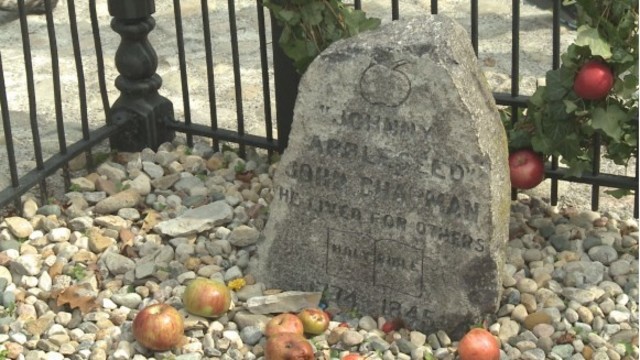John Chapman certainly seemed to want to have, or perhaps did have, his own mystical experiences—we will never know. But he did he carry the words of Swedenborg across the American frontier. Visiting homesteads, he would pull out his Bible and read passages with an ardor that calls to mind the approach of television evangelists today. Sometimes he would tear out a few pages and leave them, only to exchange them for new ones the next time he passed through. He was a vegetarian, wore no leather, and would never even cut down a tree.
Of course, on these journeys, he always had apple trees to sell. Fruit trees, often a requirement for anyone wanting to establish a land claim, provided the fruit to make applejack—hard cider—the drink of choice for the settlers at all three meals. From apple cider, settlers could make apple cider vinegar, a cleaning agent, as well as a preservative and medicinal drink. Even if the apples Chapman’s seedling produced were bitter and hard, ‘spitters’ I’ve heard them called, it didn’t matter, for they all mixed well in the grinder.
Chapman would travel into a new territory ahead of the homesteaders and establish a small nursery with seeds he picked up annually from a cider mill in Pennsylvania. He chose a protected spot near a river or stream, secured it with brambles, and traveled on. The following year he would return, dig up his one-year-old seedlings. Apple seedlings with the right conditions can grow five feet or more in a year.
My friend, Eric Schultz, who generously let me read his chapter on John Chapman in his book, Nation of Entrepreneurs, to be published by Greenleaf Publishing this fall wrote, “John Chapman was the oddest of evangelists, bringing gifts of heaven and alcohol in equal parts to the American frontier and running a business model that supported both.” There are not many followers of the Swedenborg religion today, but Chapman’s apples spread far and wide, and are certainly part of the proliferation of varieties of apples we now grow not only in America but all over the world. It’s interesting how one’s passion does not always create one’s legacy.
I think about John Chapman when I read that we have experienced the five warmest years in history. We will soon be planting Southern apples here in New England, for in not too many years, our older heirloom varieties will not have enough chill hours to produce buds. Much of this heating up of the earth is because of our selfishness and blindness to the interconnection of everything we do, build, use, and desire. Chapman was a minimalist, even during a time when there was not much to spare. His potato sack shirt had armholes cut for sleeves and probably did little to protect him from the elements, but apparently, he never complained. What would we think if we saw this man walking along our streets, barefoot with “horny” toes, wearing a tin can cap, bearded and hairy? We appreciate true iconoclasts often only after the person has died.
I came upon an interesting post, A Theology of Wild Apples, in the blog, American Orchard, Historical perspectives on food, farming and landscape.
Yet well-off travelers in the late 17th and throughout the 18th century frequently cast harsh moral judgments on the subsistence-minded farmer and his wild, disorderly orchards. And by the 1820s, many moralists found another reason to condemn the seedling orchard: most of its apples were destined to be converted to demon alcohol. Temperance societies called for the destruction of wild apple trees as an essential step toward sobering up the nation.
Chapman, born in 1774 in Leominster, Massachusetts, died in 1854 in Fort Wayne, Indiana. Fortunately, a few decades later, his younger compatriot, Henry David Thoreau, born in Concord in 1887, celebrated wilderness, wildness, and, thank goodness, wild apple trees, writing the long essay, Wild Apples, in celebration of them. There is room for both: the domesticated apple and the wild apple.
Which brings me to our orchard of ordered rows. Last Monday, we finished winter pruning, and now the twisting rhythms of branches play the ground between the trees. We pruned on those days of coldest cold stamping our feet to keep warm, and finished last Monday, a 50 degree day with honey bees out flying. Here’s to a bountiful year of apples, those planted by crow and deer, and the straight rows of nursery stock.


















